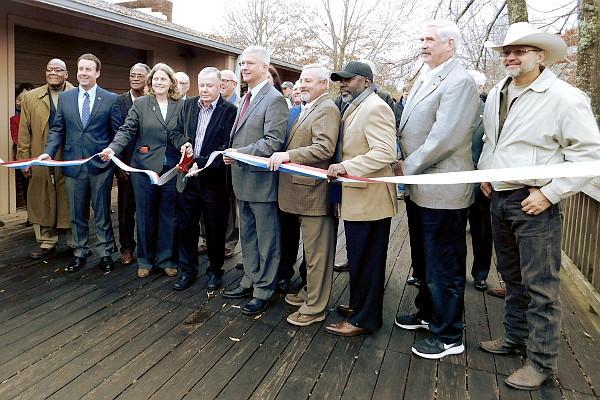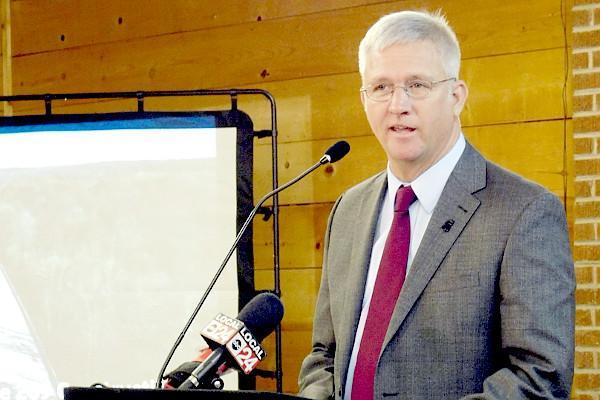
Photo by Sue Watson
Participants in the ribbon-cutting ceremony include (from left) Al Beck, David Parker, Eddie Dixon, Melinda McGrath, Tommy Woods, Andy Hughes, Mike Tagert, Bill Kinkade, John Faulkner, Kevin Blackwell and Michael Lee.

Photo by Sue Watson
Mike Tagert, transportation commissioner for the Northern District, says the I-269 project is “a crown jewel” in the state.
Second section of I-269 opens
There was much genuine celebration last week as local, state and federal officials opened a section of I-269 stretching from Highway 302 in Marshall County to Highway 305 in DeSoto County.
Mike Tagert, highway commissioner of the Northern District, praised the completion of this second segment which he said has been 20 years in the making.
The project was lauded, not only for its completion, but for the pristine landscape through which it courses and for the low environmental impact on the Coldwater River watershed.
“You built a road through the Coldwater basin; that’s one of the most environmentally sensitive areas in our region,” Tagert said.
A topdown construction method, the first of its kind in Mississippi, was used to cross the basin with the least environmental impact.
Tagert is in his seventh year as commissioner after winning a special election in February 2011 to replace Marshall County’s own Bill Minor, who died before finishing his term. Tagert is now in his second full term in office as highway commissioner.
“It’s my personal privilege to serve in this position,” Tagert said
“It’s days like this that you see the fruit of all the work it took to get there.”
Faye Woods of Byhalia was excited about the opening of more of the highway.
“What I’m excited about this interstate is I can hop on it and go see my grandchildren in Cordova,” she said.
State Rep. Bill Kinkade, who lives on Highway 309 North near I-269, said the opening of the interstate “is the single biggest event in our lifetime in 25 years.”
“I’ve watched it being built for six years from my door,” he said. “I’m personally connected to it because I see it every day. It will really spur economic development in our area.
“It’s a beautiful road. I rode it the first time this morning. It showcases that bottomland. It’s like the Natchez Trace. This is a big deal, not only for us, but for our country.”
Tagert, who was in on the project since groundbreaking of the first leg of I-269, came to the Highway Commission from the Tennessee Tombigbee Waterway Development Council.
He said every individual at the ribbon-cutting had contributed to the I-269 project and partnership.
“We take our roads for granted,” he said.
He called the I-269 project “One of the crown jewels in the state highway system.
“It is more meaningful from an economic impact,” he said. “It is something that means so much for our entire state and region. Marshall County is right there in the wings, waiting. DeSoto County is one of the top small markets in the entire country.”
The state highway system plays a critical role in job creation, education, and economic development.
“We’re sitting here with a victory in front of us,” Tagert said. “It is part of the larger vision to connect Canada, the United States and Mexico – a multigenerational project of international importance. It runs right through the heart of the Delta.
“There are very few counties in our country that get to celebrate an accomplishment like this. One of these days we will look back and say, I was here when they did that.”
“Hallelujah!” cried retired state representative Tommy Woods.
He said MDOT was born at the old Sun-N-Sand in Jackson at a breakfast with Rep. John Pennebaker. The two realized they needed a department of transportation, he said.
Woods, from Byhalia, served 25 years in the House and on the transportation committee.
Andy Hughes, administrator of the Federal Aid Highway Program, who was the principal representative of the federal highway program for Mississippi, discussed the importance of the I-69 project, a 2,730-mile corridor and the main issues at the time.
The main controversy was do you go through Memphis or around Memphis, he said, “quite controversial.”
Melinda McGrath, executive director of MDOT, summarized the construction project, saying Mississippi has to take the long view and look out about 25 years or more when thinking about transportation needs, even though revenues at the moment may look dismal.
“If you are not forward looking, you will get left out,” she said.
New construction must include new technology. Cars and trucks will soon be autonomous. Autonomous trucks are already coming through Mississippi, she said. They are trucks or cars that do not have a human driver.
It takes engineers years to make a highway plan, she said. Many agencies are involved, including the Environmental Protection Agency, Wildlife and Fisheries, Forestry as well as other departments.
It takes the Legislature to have the vision and to set laws, she said. Then the environmental process begins, followed by highway design.
“The Legislature expects us to be accountable,” McGrath said. “Plans are made available through proper funding.”
She said the new highway will begin to wear as soon as vehicles start rolling down the road.
In 10 years, it will need a new surface because of the wear.
“I believe we will look back in five years and will see how much development and change have taken place,” she said.

